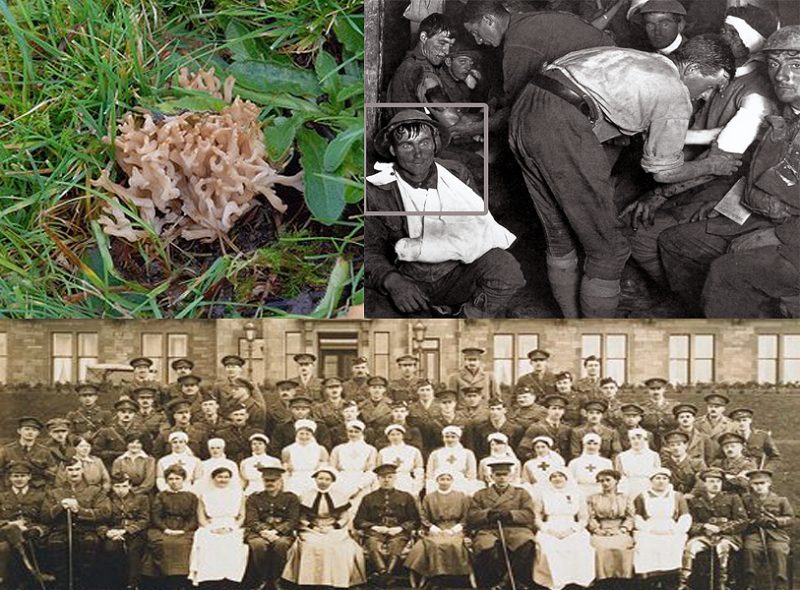Photo story (Clockwise from top left): (1) The rare fungus Clavulinopsis cinereoides was carried to Scotland from mainland Europe on WWI soldiers boots. (2) Soldiers in an Australian advanced dressing station near Ypres in 1917 with a soldier with symptom of “Shell shock” (3) Soldiers being treated and Staffs in March 1917 in front of the Craiglockhart military hospital
The rare coral fungus Clavulinopsis cinereoides which is foreign to Scotland but comparatively common in mainland Europe, has been found growing on a lawn at Craiglockhart Campus of Napier University in Edinburgh, Scotland. The discovery was made by ecologist Abbie Patterson while working on a contract to catalogue the biodiversity amongst birds, plants, lichens, mammals and invertebrates for the University, the BBC reports.
Abbie said that he had figured out a bizarre theory that the WWI soldiers’ boots may have carried the spores while tramping the Flanders fields. The University campus grounds were used as Craiglockhart military hospital where Wilfred Owen and Siegfried Sassoon, the two war poets, met in 1917. He believes that the British soldiers who visited the hospital for the treatment of shell shock brought the rare fungus spores to Scotland after picking those up on their boots. Shell shock is the inability of some WWI soldiers to reason, walk, talk or sleep because of the trauma of intense bombardment and fighting.
Abbie said that the group photographs taken during the Great War showed nurses and soldiers had been lined up on the very grassy bank where he discovered the fungus. ‘It’s hard not to make a direct link between the foreign fungus growing in Scotland and these soldiers’ he added.
Poet Owen described in his poem ‘Dulce et Decorum Est’ (1917) that the soldiers during the WWI “cursed through the sludge”.
“Bent double, like old beggars under sacks,
Knock-kneed, coughing like hags, we cursed through sludge,
Till on the haunting flares we turned our backs
And towards our distant rest began to trudge.
Men marched asleep. Many had lost their boots
But limped on, blood-shod. All went lame; all blind;
Drunk with fatigue; deaf even to the hoots
Of tired, outstripped Five-Nines that dropped behind.
Gas! Gas! Quick, boys! – An ecstasy of fumbling,
Fitting the clumsy helmets just in time;
But someone still was yelling out and stumbling,
And flound’ring like a man in fire or lime . . .”
-Wilfred Owen (Dulce et Decorum Est, 1917)
And according to Abbie some of the soldiers who have “cursed through the sludge” left a unique mark on their homeland by bringing the Clavulinopsis cinereoides. Owen was sent to the hospital as he was suffering from conditions and he met Sassoon there. He was strongly encouraged and influenced by Sassoon’s poetry.
Owen died in action in 1918 and afterwards Sassoon made great efforts to make sure his friend’s works get published. Pat Barker’s novel ‘Regeneration’ portrayed part of their friendship. It was filmed later under the same name where James Wilby played Sassoon, Stuart Bunce played Owen and Jonathan Pryce played the psychiatrist at Craiglockhart hospital named William Rivers.
Owen and Sasson were only the two of several thousand soldiers sent to that hospital for treatment. While carrying out the biodiversity audit, Patterson claims that many of the soldiers may have brought the spores of the rare fungus to Edinburg about a century ago. Abbie said that he had sent samples to other scientists and they confirmed that it was Clavulinopsis cinereoides.
The rare fungus has now been accepted and entered into records as a first for Scotland. ‘My specimen is now with the herbarium of Edinburgh Botanic Garden and is the only specimen of this species they have’ Abbie added. He also said that his biodiversity audit also uncovered several other rare plants around the old hospital ground. He said that these plants had survived because the grounds of Craiglockhart had not been treated with chemicals or weedkillers over the years.
Video story: Recitation of the poem Dulce et Decorum Est (1917) written by Wilfred Owen
